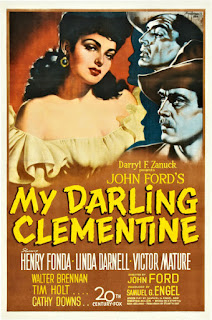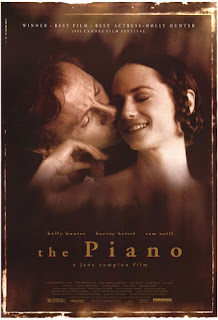September 15th: MY DARLING CLEMENTINE (John Ford, 1946)
The unruly frontier town of Tombstone gives way to community and law and order.
By the early 1940s, John Ford was already one of Hollywood's most successful and acclaimed filmmakers, with three Oscars for directing to his credit. When the United States entered World War II, he served as an officer in the Navy's photographic unit, making documentary and propaganda films, and present at the legendary Battle of Midway and on Omaha Beach on D-Day.
His first film after the end of the war was the last in a contract with 20th Century Fox studio head Darryl F. Zanuck, and a return to the genre that had served him well in the past: the western. Based primarily on famously exaggerated biographies of Wyatt Earp by Stuart Lake (and already filmed twice before), Ford also relied on personal conversations he had with Earp himself while working on early silent films in the 1910s.
Ford shot the film on location in Monument Valley near the Arizona-Utah border, where his previous hit Stagecoach was made, and which he would return to again and again for the rest of his career. While not geographically accurate for Tombstone, Ford chose the spot partially to economically benefit the nearby Navajo Indian community.
Instead of reuniting with John Wayne, the movie star he created, Ford turned to another previous collaborator in fellow Navy veteran Henry Fonda, who perhaps struck a more noble figure as Earp. Upcoming star Victor Mature was cast as "Doc" Holliday, with recent pin-up sensation Linda Darnell in the standby prostitute role. Three-time Oscar-winner Walter Brennan played one of the villains, and members of Ford's "stock" company of actors present included Tim Holt and Ward Bond.
Instead of attempting to unearth historical veracity within the Tombstone/Earp mythology, Ford turned the film into much more of a reflective mood piece, shooting in black & white and favoring expressionistic indoor lighting and stark outdoor vistas. Present is his recurring theme of community, depicted in fine detail, and bolstered by the set life of the production company: cast and crew camped out on location, with Ford organizing nightly entertainment including dancing and live music.
Ford's standard approach was to shoot only the shots and scenes he needed, arguably to safeguard against studio/producer meddling. Zanuck was not pleased with the director's first cut of the film, finding it too leisurely-paced and not commercial enough for the large budged he had supplied. Ford was unwilling to make the requested changes, so Zanuck had additional scenes shot with a different director (including a new ending), cut approximately 30 minutes, and increased the usage of Alfred Newman's musical score.
The film was a huge commercial success, though like most of Ford's westerns did not receive much awards consideration. It is now regarded as one of his greatest films and one of the highlights of the genre. A print of the "pre-release version" (somewhere in the middle of Zanuck's alterations) has been preserved by the UCLA Film & Television Archive, and contains more of Ford's original intentions.











Comments
Post a Comment